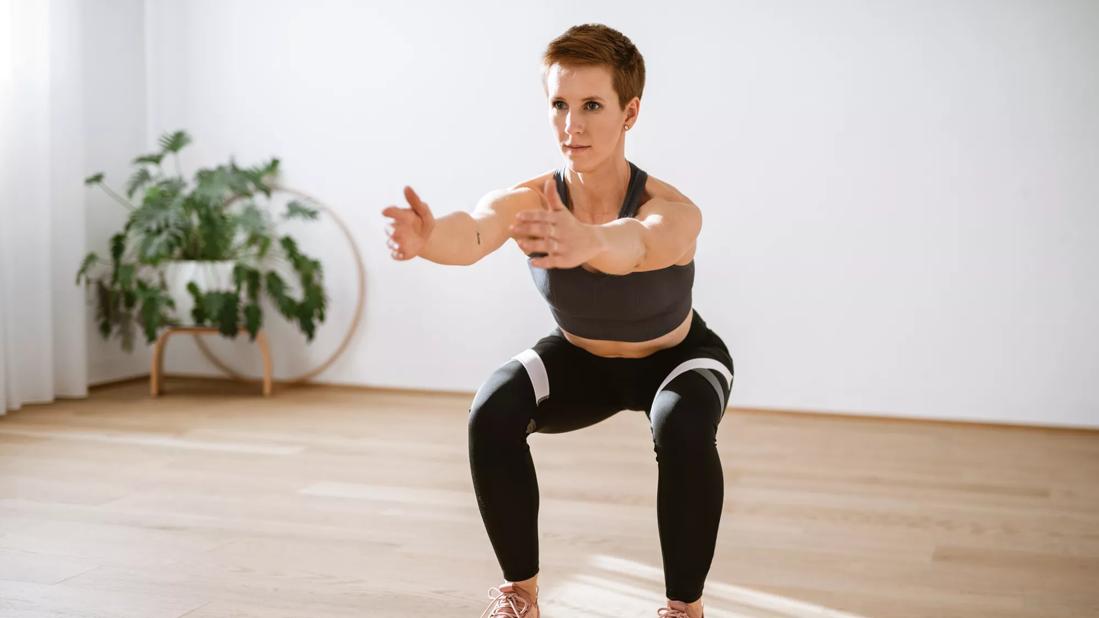Squats are foundational for building strength in your legs, glutes, quads and core muscles

Squats may seem simple on the surface, but they’re much more than just squatting to the floor and rising back up in quick succession. When done correctly, squats build strength across several different muscle groups and help improve stability, flexibility and more.
Advertisement
Cleveland Clinic is a non-profit academic medical center. Advertising on our site helps support our mission. We do not endorse non-Cleveland Clinic products or services. Policy
Doing squats the wrong way, though, opens yourself up to potential injury — so it’s important to know how to do them right.
Sports medicine physician Matthew Kampert, DO, explains the benefits of squats and how to maximize their positive effects with proper form and technique.
Squats are an important exercise to help build lower body strength in your thighs, hips and butt. They also help build strength in the core muscles of your abdomen and lower back. All of this leads to improvements in your:
"Squats are integral to athletic training programs, enhancing speed, agility, strength and power across various sports disciplines," says Dr. Kampert. "They also help you achieve everyday goals, especially as you age, so that you can continue to bend over or lift heavy objects."
In addition to improving strength, balance and endurance, proper squat form provides these additional benefits:
Squats are a popular and foundational exercise because they engage multiple major muscle groups, including your:
Squatting helps burn calories both during and after exercise. One study found that squats burn about 35 calories per minute, aiding in weight management and fat loss.
Advertisement
"Squatting also stimulates the release of hormones like testosterone and somatotropin," Dr. Kampert says, "which are vital for muscle growth, metabolism and overall health."
Squat exercises are commonly used in strength training routines for many athletes, but they’re helpful for anyone who’s interested in improving their lower body strength. Your lower body fuels your ability to:
"By focusing on lower body strength, you also lower your risk of injuries like hip flexor strains and sports hernias," says Dr. Kampert.
You’re more prone to falls and injury as you age, but regularly incorporating squats into your exercise routine can help keep you balanced.
"Strong glutes, for example, are essential for stability in various movements," Dr. Kampert points out, "and the hip flexor muscles, calf muscles and adductors all contribute to maintaining balance and stability."
Poor posture can cause all kinds of problems, including
By doing exercises like squats, you can work on the muscles that support your spine and improve your posture over time.
Squats and other types of physical activity can improve your ability to move and walk more freely. It also helps you turn or change direction while reducing your risk of injury.
"Squatting promotes flexibility and mobility in the hips, knees and ankles," says Dr. Kampert. "That can help improve athletic performance, prevent injuries and alleviate joint pain."
Studies show that squats are one of a few types of exercises that can increase bone mineral density in people who already have osteoporosis. Why? Because they’re high-intensity, high-impact, weight-bearing exercises.
"These kinds of exercises help reduce the risk of osteoporosis and promote long-term bone health," Dr. Kampert adds.
"The action of squatting mimics everyday movements like sitting and standing," Dr. Kampert points out. "This enhances your ability to efficiently perform these activities and reduces your risk of injury."
When you’re squatting, keep your:
Maintaining this proper form will limit your chances of strain or injury while doing these exercises. It also helps to remember the difference between eccentric and concentric stages of squats as you slowly move toward the ground and then quickly push up from a squatting position.
Here's how to do a basic squat correctly:
Advertisement
If squatting proves difficult, you can hold onto a sturdy chair, countertop or railing for added balance and support. You can also do squats with your back against the wall.
Performing a proper squat requires engaging your core and continuing to breathe as you move through each step. To avoid hurting yourself, it’s important to maintain this form and be consistent for each rep.
Dr. Kampert suggests these tips to make the most out of squats:
Advertisement
It’s normal to experience some discomfort while you exercise, but you shouldn’t feel any sharp or sudden pain. If you do, consult a healthcare provider, physical therapist or athletic trainer who can evaluate your form and locate your source of pain.
“They’ll be able to provide personalized guidance and recommendations based on your individual goals and fitness level,” advises Dr. Kampert.
As with any exercise, remember: Squats take practice. The more you do them, the better you’ll get. As your strength, flexibility and mobility improve, so, too, will your squatting abilities.
Advertisement
Learn more about our editorial process.
Advertisement

A consistent walking program is an effective way to drop pounds and lose body fat

You can improve your athletic performance over time by breaking up your workout regimen into focused cycles

Shoulder rolls, hamstring stretches and calf exercises can all improve flexibility and endurance

Lower-intensity workouts can deliver high-quality health and fitness results

Incremental changes in your exercise routine can improve your strength and endurance over time

Understanding heart rate zones can help you tailor your workout to reach your goals

Increase the size of your muscles by bulking up on protein and focusing on slow, intense movements with progressive overloading

Low-impact exercises help you recover faster between sets, during cool downs and on rest days

Start having sex about 72 hours before ovulation, then at least every other day during your fertile window

Attachment theory suggests that your earliest relationships shape connections throughout your life

It isn’t a recognized mental health disorder, but research shows that problematic social media use can negatively affect your mental health, self-esteem and sleep